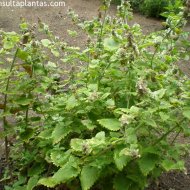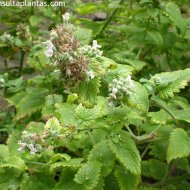Care of the plant Nepeta cataria or Catnip |
|
The genus Nepeta, family Lamiaceae, includes about 250 species of herbaceous plants native to Europe, Asia, and Africa. Some species and hybrids are: Nepeta cataria, Nepeta × faassenii, Nepeta grandiflora, Nepeta teydea, Nepeta curviflora, Nepeta nepetella, Nepeta tuberosa. Common names: Catnip, Catswort, Catmint or Catwort. This species is native to Europe, the Middle East, and Central Asia. They are perennial herbaceous plants with gray stems that reach 60 cm (23.6") in height. Opposite, heart-shaped leaves with jagged edges are hairy on the undersides and give off a light citrus scent. The small whitish flowers appear in spikes. They bloom in late summer and early fall. The leaves and flowers attract cats that chew them and come to adopt curious behaviors. Catnip is used in rockeries, borders and borders, as isolated specimens, in Mediterranean gardens and in pots for patios and terraces. It attracts butterflies and repel aphids, mosquitoes and cockroaches. Nepeta cataria can live in full sun and semi-shade exposures. Catswort grows in any type of soil that has good drainage. Water moderately waiting for the substrate to dry. Catmint resists drought well. Catnip does not need fertilizer. Prune lightly after flowering to maintain a compact habit. Nepeta cataria is a quite resistant plant to the usual pests and diseases but it can be attacked by fungi, snails and slugs. Catswort is propagated from seeds sown in spring, by division, and by cuttings in summer or fall. It haves a tendency to self-propagate from seed. |
Images of the plant Nepeta cataria or Catnip |
Find plants
Nepeta cataria or Catnip | Care and Growing
© 2025 FavThemes

